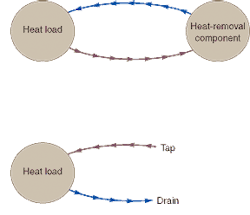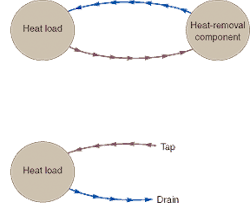Ten rules to guide liquid-cooling decisions
By Kathryn Whitenack
An effective cooling loop can help avoid potential performance and service-life problems caused by excessive waste-heat generation in most lasers.
A liquid-cooling loop consists of a heat source in which the liquid picks up the heat, and a cooling component in which the liquid rejects the heat. The heat source could be a cold plate with electronics mounted to its surface or the laser head itself. The cooling component could be a liquid-to-air heat exchanger, a liquid-to-liquid heat exchanger, or a refrigerated system such as a recirculating chiller. Developing an appropriate cooling strategy can be a daunting task. Subtle issues, resulting in an inadequate cooling solution, can be easily overlooked. The following checklist can serve as a guide in choosing the correct cooling system.
By contrast, closed-loop systems, such as ambient systems or recirculating chillers, continually recycle the coolant, making them more environmentally friendly (see figure). The initial cost of closed-loop systems are usually higher, but the payback period is surprisingly shortonly about nine months for a recirculating chiller and even shorter for an ambient system.
3. Choose an unrefrigerated system or a chiller based on temperature stability requirements. If the set point is above the ambient air or facility water temperature, and if tight temperature control is not required, an unrefrigerated cooling approach will work. In such a system, ambient air passing over the fins of a liquid-to-air heat exchanger or facility water flowing through a liquid-to-liquid heat exchanger extracts the heat that the coolant picked up from the heat source.However, if the desired set point is below typical ambient conditions or if set-point stability is critical, then a refrigerated system such as a recirculating chiller is necessary. A chiller is similar to a home refrigerator except that it removes heat from the coolant rather than air. The set-point stability of a typical chiller is 0.1°C.
4. Packaged cooling system vs. components to build a custom system. A complete system comes equipped with pumps and reservoirs, while a custom system would require the user to build and integrate the components. For unrefrigerated cooling, selecting individual components gives more design flexibility to fit everything into the existing cabinet. However, there may be an element of guesswork if the designer is not an expert in designing cooling systems. Choosing a packaged system ensures that the components are performance-matched.If a chiller is required, a prepackaged system is the best option because it will easily integrate with the laser. Refrigerated systems are too complex for end-user assembly. Moreover, federal law limits the handling of refrigerants to licensed technicians, which is prompting the trend toward turnkey systems.
5. Weigh the tradeoffs between standard and custom systems. Use a standard package whenever possible, even if it provides a few extra features. Custom packages inevitably introduce longer lead times and higher costs. If specialized features are required, however, a custom approach may be necessary.6. Understand the limitations of tap and deionized water. Tap water may seem to be an easy low-cost alternative, but it contains minerals and chemicals that can cause scaling, which blocks small fittings, tubes, and microchannels, and can compromise cooling. Deionized (DI) water can reduce the potential for sediment as well as reduce the electrical conductivity of the coolant. But DI water is extremely corrosive and prone to contamination, necessitating the use of noncupric, corrosion-resistant materials, like stainless steel for heat exchanger tubes, or nickel for evaporators and special fittings.In applications with set points below 15°C (55°F) or cooling loops that contain aluminum fluid paths, the coolant should be a mixture of ethylene glycol and water to prevent freezing and corrosion, respectively. Always use an algaecide, such as Chloramine-T, to reduce algae growth in the system.
7. Choose a pump that best suits the application. A liquid cooling system will probably include a positive-displacement pump, a centrifugal pump, or a turbine pump. Positive-displacement models provide a constant flow regardless of pressure drop in the system. The use of progressively smaller tubing sizes, 90° bends, and long lines result in large fluid pressure drops. On the other hand, the flow from a centrifugal or turbine pump depends on the system's pressure drop. Centrifugal pumps are well suited for low-pressure applications, while turbine pumps are well suited for high-pressure applications. Although centrifugal and turbine pumps initially cost more than positive displacement pumps, they offer longer service lives, typically 27,000 hours vs. the 7000 hours offered by positive displacement pumps.8. Manage fluid flow and pressure. Flow control valves manage fluid flow and pressure control valves manage pressure. In either case, the valve reduces flow or pressure by siphoning off fluid before it enters the cooling system. This can prevent leaks that can result from high pressure and manage the flow through the cooling loop. If a system delivers inadequate flow or pressure, most likely the pump is undersized for the application.9. Decide how to extract the heat from the cooling fluid. In ambient systems, air passing over the heat exchanger's fins extracts heat from the coolant. Alternatively, the heat can be transferred from the coolant to a secondary liquid, typically facility water, via a liquid-to-liquid heat exchanger. Chillers can also be air or liquid cooled. But whether the residual heat from the coolant goes into the air or into facility water, a decision as to where the hot air or hot water will be dumped must be made. 10. Choose a control system that best suits currentand anticipated needs. Control systems can vary greatly in features and functionality. Most ambient systems do not have a control system. A basic chiller may provide a temperature display, flow and pressure sensing, and basic set-point controls. A mid-range chiller typically includes alarms for low levels and for low and high temperatures, as well as an automatic fault-shutoff and other programmable features. An upper-range package may add computer interfaces to facilitate remote control and data logging. The wisest approach is to be sure the controller has everything that may be needed in the futurein the long run it will perform better and cost less.KATHRYN WHITENACK is director of marketing at Lytron Inc., 55 Dragon Ct., Woburn, MA 01801; e-mail: [email protected].

